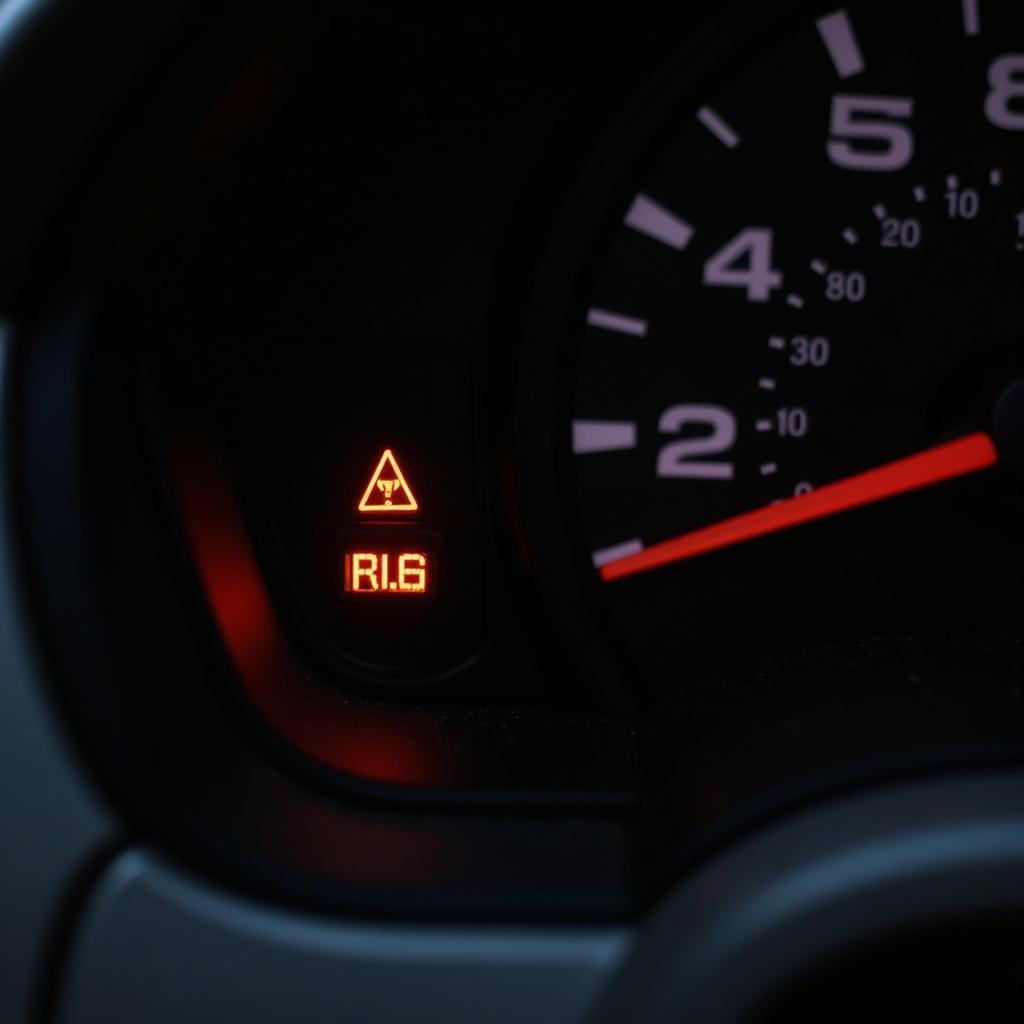The brake warning light on your 2004 Honda Accord is a crucial safety feature that alerts you to potential issues with your braking system. Ignoring this light could lead to dangerous situations on the road. This comprehensive guide will delve into the common causes of a 2004 Honda Accord brake warning light, provide troubleshooting steps, and offer potential solutions to get you back on the road safely.
 2004 Honda Accord dashboard with brake warning light illuminated
2004 Honda Accord dashboard with brake warning light illuminated
Understanding Your Brake Warning Light
The brake warning light, often depicted as a circle with an exclamation mark (!) or the word “BRAKE” inside, can illuminate for several reasons. It’s essential to understand that this light doesn’t always signal a complete brake failure.
Common reasons for the brake warning light to illuminate include:
- Low brake fluid level: This is the most common reason. Brake fluid is essential for transmitting force from the brake pedal to the wheels, ensuring proper braking.
- Engaged parking brake: Accidentally leaving the parking brake partially engaged can trigger the light.
- Faulty brake light switch: This switch activates your brake lights when you press the pedal. A malfunction can illuminate the warning light.
- Worn brake pads: Brake pads naturally wear down over time. Most vehicles have wear indicators that contact the rotor and trigger the warning light when the pads become too thin.
- ABS issue: If there’s a problem with your Anti-lock Braking System (ABS), the warning light might illuminate along with the ABS light.
Troubleshooting Your 2004 Honda Accord Brake Warning Light
Before you begin:
- Safety First: Park your car on a level surface and engage the parking brake before beginning any inspection.
- Gather Supplies: You might need basic tools like a flashlight and a rag or paper towels.
Step-by-Step Troubleshooting:
- Check the parking brake: Ensure it’s fully disengaged.
- Inspect the brake fluid level: Locate the brake fluid reservoir under the hood. The reservoir will be clearly labeled. Check the fluid level. If it’s low, add the correct type of brake fluid for your 2004 Honda Accord. Consult your owner’s manual for the recommended brake fluid type.
- Inspect brake pads visually: If possible, look at the brake pads through the wheel spokes. If you see very thin pads or metal-on-metal contact, your pads likely need replacement.
- Listen for unusual noises: While driving slowly, listen for any scraping or grinding noises when applying the brakes. These sounds can indicate severely worn brake pads.
 Person checking brake fluid level in a 2004 Honda Accord
Person checking brake fluid level in a 2004 Honda Accord
When to Seek Professional Help
If the troubleshooting steps above don’t resolve the issue, or if you’re uncomfortable performing them, it’s crucial to seek professional assistance. A qualified mechanic can diagnose the problem accurately using specialized tools and knowledge.
Here are situations where professional help is strongly advised:
- Brake fluid leak: If you suspect a brake fluid leak (evident by fluid under your car or a consistently dropping fluid level), seek immediate professional help.
- Warning light remains on after adding fluid: This could indicate a more serious issue, like a faulty brake caliper or master cylinder.
- ABS warning light illuminated: Issues with the ABS system require specialized knowledge and equipment to diagnose and repair.
Remote Diagnostics and Software Solutions
In today’s technologically advanced automotive landscape, remote diagnostics and software solutions offer a convenient and efficient way to address certain brake warning light issues.
“Remote diagnostics allow us to connect to a vehicle’s onboard computer system from anywhere,” says John Miller, Senior Automotive Diagnostic Technician at AutoFix Technologies. “This allows us to read error codes, analyze data, and potentially pinpoint the cause of a brake warning light without the car ever coming into the shop.”
Benefits of Remote Diagnostics and Software Solutions:
- Convenience: Diagnostics can be performed from the comfort of your home or office.
- Faster Diagnosis: Remote access to vehicle data can often expedite the diagnostic process.
- Software Updates: Some brake warning light issues, particularly those related to the ABS system, can be resolved with software updates installed remotely.
Finding a Qualified Remote Diagnostics Provider:
Not all mechanics or service centers offer remote diagnostics. It’s essential to find a reputable provider with expertise in your vehicle’s make and model. Look for ASE-certified technicians who specialize in diagnostics and electronic systems.
 Mechanic using a laptop for remote car diagnostics
Mechanic using a laptop for remote car diagnostics
Maintaining Your Braking System
Proactive maintenance is key to preventing brake issues and ensuring your safety on the road. Follow these maintenance tips to keep your 2004 Honda Accord’s braking system in optimal condition:
- Regular Brake Inspections: Have your brakes inspected by a qualified mechanic at least once a year or every 12,000 miles, whichever comes first.
- Brake Fluid Flush: Brake fluid absorbs moisture over time, which can reduce braking efficiency. It’s essential to have your brake fluid flushed and replaced according to the manufacturer’s recommendations.
- Quality Brake Pads: Invest in high-quality brake pads designed for your 2004 Honda Accord.
- Address Warning Signs Promptly: Never ignore dashboard warning lights, unusual noises, or changes in brake pedal feel.
Conclusion
The brake warning light in your 2004 Honda Accord is a critical safety feature. Understanding its various triggers and following the troubleshooting steps outlined in this guide can help you address the issue or determine when professional help is necessary. By prioritizing brake system maintenance and taking advantage of advanced diagnostic solutions, you can enjoy a safer and more confident driving experience.

